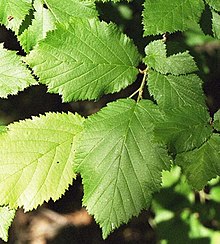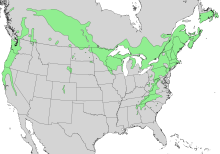Corylus cornuta
| Corylus cornuta | |
|---|---|

| |
| Beaked hazel foliage | |
| Scientific classification | |
| Kingdom: | Plantae |
| Clade: | Tracheophytes |
| Clade: | Angiosperms |
| Clade: | Eudicots |
| Clade: | Rosids |
| Order: | Fagales |
| Family: | Betulaceae |
| Genus: | Corylus |
| Species: | C. cornuta
|
| Binomial name | |
| Corylus cornuta | |

| |
| Natural range of Corylus cornuta | |
| Synonyms[1] | |
|
List
| |
| Nutritional value per 100 g (3.5 oz) | |
|---|---|
| Energy | 2,629 kJ (628 kcal) |
22.98 g | |
| Dietary fiber | 9.8 g |
52.99 g | |
14.89 g | |
| Vitamins | Quantity %DV† |
| Thiamine (B1) | 42% 0.480 mg |
| Riboflavin (B2) | 13% 0.160 mg |
| Niacin (B3) | 21% 3.190 mg |
| Vitamin B6 | 42% 0.550 mg |
| Minerals | Quantity %DV† |
| Calcium | 44% 441 mg |
| Copper | 60% 1.200 mg |
| Iron | 24% 3.12 mg |
| Magnesium | 66% 235 mg |
| Manganese | 362% 7.600 mg |
| Phosphorus | 59% 411 mg |
| Potassium | 16% 738 mg |
| Sodium | 0% 2 mg |
| Zinc | 22% 2.06 mg |
| Other constituents | Quantity |
| Water | 5.92 g |
| |
| †Percentages are roughly approximated using US recommendations for adults. Source: USDA FoodData Central | |
Corylus cornuta, the beaked hazelnut (or just beaked hazel), is a deciduous shrubby hazel with two subspecies found throughout most of North America. The Eastern beaked hazel is found from southern Canada south to Georgia, while the Western beaked hazel occurs along the west coast from Alaska to California.
Description[]
It can reach 4–8 metres (13–26 ft) tall with stems 10–25 cm (4–9+3⁄4 in) thick with smooth gray bark,[2] but it can also remain relatively small in the shade of other plants. It typically grows with several trunks.
The leaves are green, rounded oval with a pointed tip, coarsely double-toothed, 5–11 cm (2–4+1⁄4 in) long and 3–8 cm (1+1⁄4–3+1⁄4 in) broad, with soft and hairy undersides.
The male flowers are catkins that form in the fall, and pollinate the single female flowers the following spring to allow the fruits to mature through the summer season.
The beaked hazelnut is named for its fruit, which is a nut enclosed in a husk with a tubular extension 2–4 cm (3⁄4–1+1⁄2 in) long that resembles a beak. Tiny filaments protrude from the husk and may stick into, and irritate, skin that contacts them. The spherical nuts are edible, though small and surrounded by a hard shell. The beaked hazel is the hardiest of all hazel species, surviving temperatures of −50 °C (−58 °F) at its northern limits.[2]
It has a shallow and dense root system which is typically only 15 centimetres (5.9 in) deep, with a single taproot which may extend 0.6 metres (2.0 ft) below the surface.[3]
Varieties[]
There are two varieties, divided by geography:[3]
- Corylus cornuta var. cornuta – Eastern beaked hazel. Small shrub, 4 to 6 m (13 to 20 ft) tall;[3] 'beak' longer, 3 cm (1+1⁄4 in) or more. Occurs from 100–500 metres (330–1,640 ft) throughout its range, and up to 1,000 metres (3,300 ft) in Alberta.[3]
- Corylus cornuta var. californica – Western beaked hazel or California hazelnut. Large shrub, 4 to 15 m (13 to 49 ft) tall;[3] 'beak' shorter, usually less than 3 cm (1+1⁄4 in). Occurs below 2,100 metres (6,900 ft) in California, and below 800 metres (2,600 ft) in British Columbia. The Concow tribe called this variety gōm’-he’’-ni (Konkow language).[4]
Ecology[]
Although C. cornuta is somewhat shade tolerant, it is more common in forests with fairly open canopies than denser ones.[3] However, it is intolerant of entirely open areas that get hot and dry.[2]
Fire kills the above-ground portion of the shrub, but it resprouts fairly readily after fire from its root crown or rhizomes. It recovers after fire to the extent that American Indians in California and Oregon used fire to encourage its growth. [3]
In boreal regions, it is threatened by the invasive Siberian peashrub, which can invade and achieve dominance in understories.[3]
Use by Animals[]
Deer, moose, and livestock browse the foliage of the Eastern beaked hazel, but the Western beaked hazel is considered to have low palatability for ungulates.[5] The hazelnut weevil feeds solely off the Western beaked hazel.[3]
American beavers prefer Eastern beaked hazel browse, and consume it to such an extent that they reduce its relative abundance in favor of conifers.[3]
The nuts of C. cornuta californica are an important food source for squirrels, especially as a backup in times of acorn crop failure. Species such as Douglas squirrels, red squirrels and least chipmunks gather and stash the nuts, and although up to 66% of the nuts are consumed, the remainder have an elevated chance of germination due to being buried in soil or leaves. Although squirrels only distribute the nuts about 90 metres (300 ft) or less, Jays such as the Blue Jay in the east and the Steller's Jay in the west distribute them over longer distances. Black Bears, turkeys, and white-tailed deer also consume the nuts.[3]
Ruffed grouse consume the protein-rich catkins and young buds of Corylus cornuta.[3]
It is used as cover by a variety of animal species, and provides good nesting for birds, especially the ruffed grouse. The white-footed vole is positively correlated with California hazelnuts in the Umpqua National Forest in Oregon. [3]
Human Uses[]
Native Americans used the sprouts to create baskets, fish traps, and baby carriers. The nuts were eaten and commonly used as a trade good among indigenous groups- both the Lewis and Clark expedition and prolific early naturalist David Douglas bartered for beaked hazelnuts with local peoples they encountered. It was used medicinally as emetic, for deworming, as an astringent, and for teething.[3]
It is considered an excellent nut, with the same uses as any hazelnut.[6] While the beaked hazelnut does not produce as many nuts as commercial European species such as the common hazel or filbert, it is more resistant to common diseases, and has been used in breeding programs to create high-yield, disease resistant hybrids.[3]
It is used in restoration plantings to increase biodiversity, improve food sources for wildlife, and to reduce rates of laminated root rot in nearby Douglas-fir and Sitka spruce.[3]
Gallery[]
Male catkins

Female flowers

Leaves (and three fruits forming)

Immature fruit showing the "beak"

An immature nut with its hard shell
References[]
- ^ "Corylus cornuta Marshall". Plants of the World Online. Board of Trustees of the Royal Botanic Gardens, Kew. Retrieved 8 April 2021.
- ^ a b c "Corylus cornuta" (PDF). Alberta Centre for Reclamation and Restoration Ecology. University of Alberta. Archived from the original (PDF) on 23 August 2016. Retrieved 22 November 2017.
- ^ a b c d e f g h i j k l m n o p Fryer, Janet L. (2007). "Corylus cornuta". Fire Effects Information System (FEIS). US Department of Agriculture (USDA), Forest Service (USFS), Rocky Mountain Research Station, Fire Sciences Laboratory – via https://www.feis-crs.org/feis/.
{{citation}}: External link in|via= - ^ Chesnut, Victor King (1902). Plants used by the Indians of Mendocino County, California. Government Printing Office. p. 405. Retrieved 24 August 2012.
- ^ Whitney, Stephen (1985). Western Forests (The Audubon Society Nature Guides). New York: Knopf. p. 428. ISBN 0-394-73127-1.
- ^ Nyerges, Christopher (2017). Foraging Washington: Finding, Identifying, and Preparing Edible Wild Foods. Guilford, CT: Falcon Guides. ISBN 978-1-4930-2534-3. OCLC 965922681.
External links[]
 Media related to Corylus cornuta at Wikimedia Commons
Media related to Corylus cornuta at Wikimedia Commons- Calflora
- Sawyer Jr., John O. (2012). "Corylus cornuta subsp. californica". In Jepson Flora Project (ed.). Jepson eFlora. The Jepson Herbarium, University of California, Berkeley.
- Corylus cornuta in the CalPhotos photo database, University of California, Berkeley
- Corylus
- Flora of North America
- Plants described in 1785
- Edible nuts and seeds
- Garden plants of North America
- Ornamental trees




